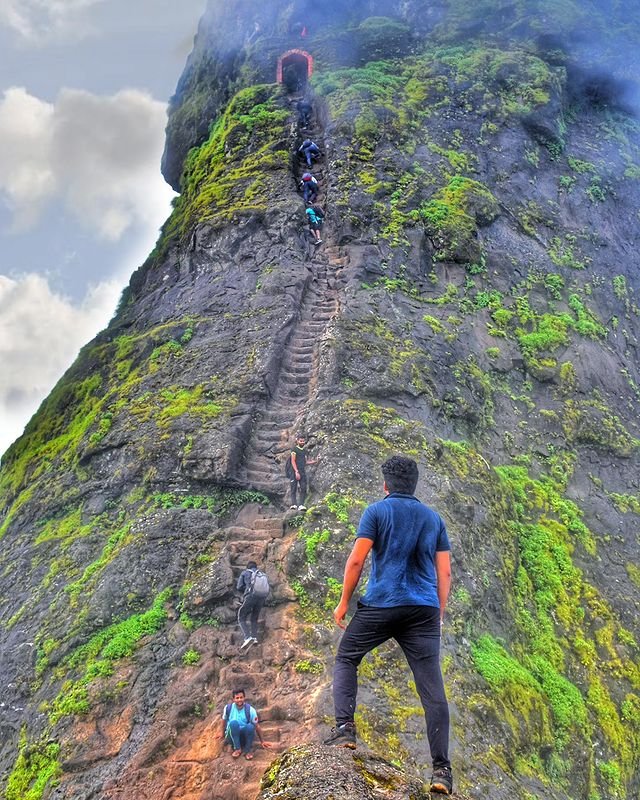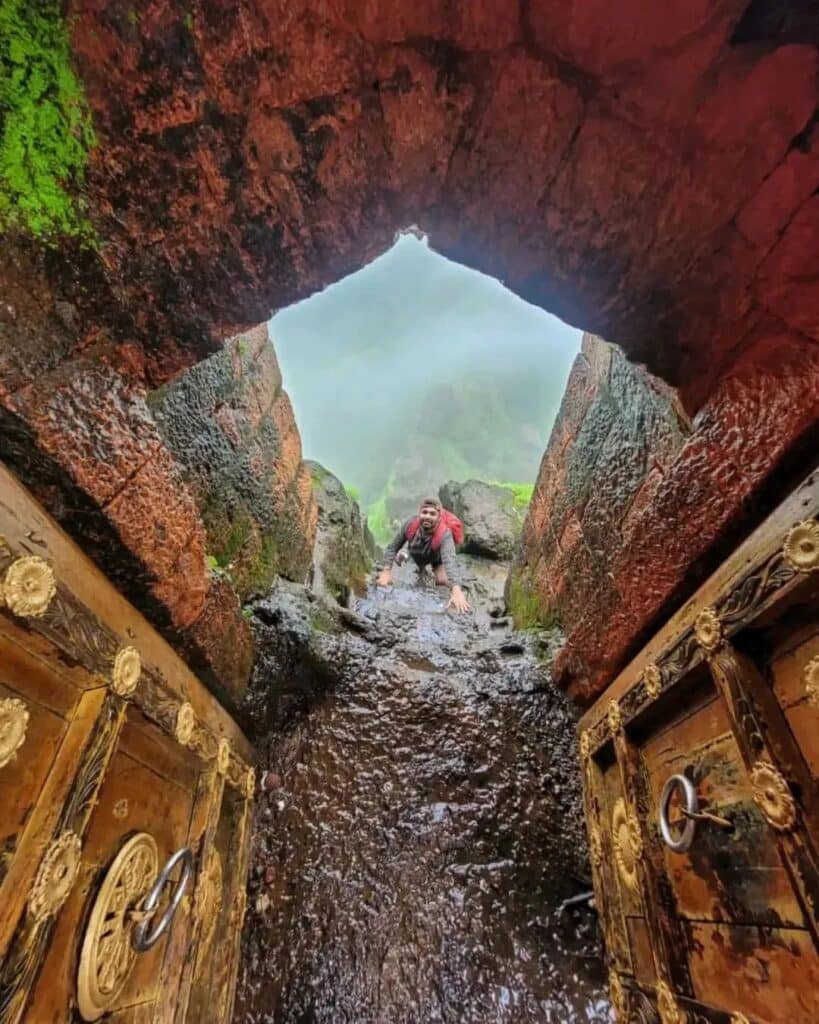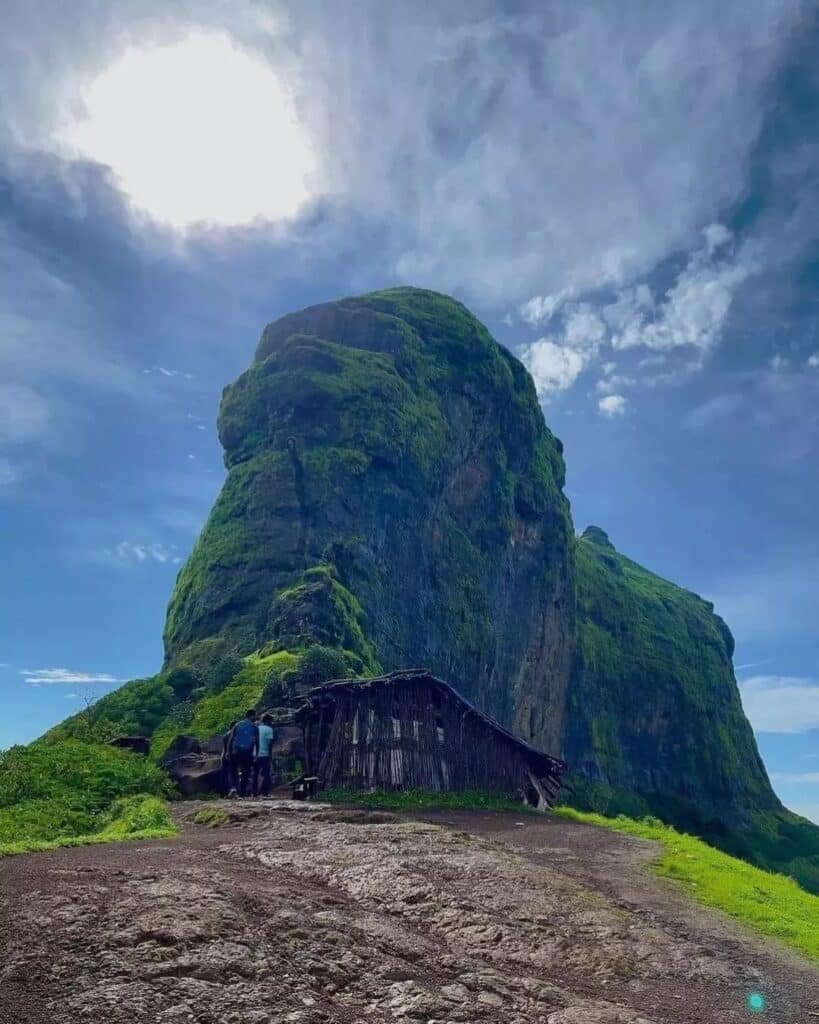Harihar Fort Trek Ultimate Guide (2024)
- Trekking Destinations
-
Jun 28
- Share post
Harihar Fort, located in Maharashtra, India, is a testament to the region’s rich history and natural beauty.
With its steep rock-cut steps, intricate architecture, and breathtaking panoramic views, the fort entices adventure enthusiasts and history buffs alike.
In this article, we will delve into the historical significance of Harihar Fort, explore the trekking route, provide preparation tips, share the trekking experience, and highlight the fort’s architectural marvels and the stunning surroundings it offers.
- Max Altitude: 3,676 Ft.
- Average Trekking Fees: ₹900 – ₹1,200
- Distance: 4 – 5 kms
- Difficulty: Moderate
- Duration: 3 – 4 hours
- Ideal For: Experienced Trekkers Only
- Best Season: July – September & November – February
- Region: Maharashtra
Table of Contents
ToggleOverview of the Harihar Fort

The Harihar Fort trek offers an exhilarating experience for adventure enthusiasts. Located in Maharashtra, India, this trek is known for its historical significance and breathtaking views. The fort stands tall at an elevation of 3,676 feet and is surrounded by rugged terrain.
The trek starts with a moderate hike through dense vegetation and rocky patches. As you ascend, the real challenge begins with the famous “staircase to heaven,” a steep rock-cut staircase. Climbing these stairs requires concentration and careful footing. The narrow pathways and steep edges add to the thrill.
Once you reach the top of the fort, you’ll be awarded panoramic views of the surrounding landscapes. On a clear day, you can witness the beauty of the Sahyadri mountain range and the Trimbakeshwar Temple. The Harihar Fort itself boasts ancient architecture, including the stunning Harihareshwar temple.
Carrying sufficient water and wearing comfortable trekking shoes for this adventure are essential. Beginners may find this trek moderately difficult, but it is achievable with proper guidance and precautions.
Overall, the Harihar Fort trek is a thrilling experience that combines history, nature, and adrenaline. It’s an opportunity to test your endurance, enjoy mesmerising views, and immerse yourself in the rich heritage of Maharashtra.
Historical Significance of Harihar Fort
Harihar Fort, also known as Harshagad, holds immense historical importance. Built during the Yadava dynasty and later captured by various rulers, including the Mughals and the Marathas, the fort played a crucial role in defending the region. Its strategic location atop a triangular prism-shaped rock made it an ideal stronghold. Today, it stands as a living testament to the architectural prowess of the bygone era.
How To Reach Harihar Fort?

You have multiple transportation options to reach the start point of the Harihar Fort trek from Mumbai. The most convenient way is to take a train or bus to Igatpuri, which is approximately 130 kilometres away from Mumbai. From Igatpuri, you can hire a private vehicle or take a local bus to Nirgudpada, the base village of the trek. The distance from Igatpuri to Nirgudpada is around 40 kilometres, and it takes approximately 1.5 to 2 hours to reach by road.
If you prefer travelling by a local train, you can board a local train from Mumbai to Kasara, which is approximately 100 kilometres away. From Kasara, you can take a bus or hire a private vehicle to reach Nirgudpada. The distance from Kasara to Nirgudpada is around 45 kilometres, and the journey usually takes about 1.5 to 2 hours.
For those starting the trek from Pune, the best way is to take a train or bus to Igatpuri, similar to the Mumbai route. The distance between Pune and Igatpuri is approximately 240 kilometres, and it takes around 4 to 5 hours by road. From Igatpuri, follow the same route mentioned above to reach Nirgudpada.
It’s important to note that travel times can vary depending on traffic conditions and the mode of transportation chosen. It’s recommended to check the train or bus schedules in advance and plan your journey accordingly.
Additionally, starting early in the day is advisable to allow ample time for the trek and return journey.
Harihar Fort: Trekking Route & Difficulty

The Harihar Fort trek route takes you through a challenging yet rewarding journey. Starting from the base village of Nirgudpada, the trail begins with a gradual ascent through lush greenery and scenic landscapes. The initial part of the trek is relatively easy, allowing you to warm up and get accustomed to the surroundings.
As you progress, the terrain becomes more rugged and demanding. The highlight of the trek is the famous “staircase to heaven.” These stone-cut steps are steep and narrow, requiring careful navigation. The climb up the staircase can be physically demanding and may require some scrambling and using hands for support.
After conquering the staircase, the trail continues along a narrow ridge with a sheer drop. This section demands caution and a steady footing. The route then leads to a small plateau where you can catch your breath & admire the awe-inspiring views.
The final stretch involves a steep rock patch that leads to the fort’s entrance. This part requires careful manoeuvring and may be challenging for beginners. However, the sense of accomplishment upon reaching the fort makes it all worthwhile.
Overall, the Harihar Fort trek is considered moderately difficult. The steep staircase, narrow pathways, and rocky patches add to the challenge. It is advisable to have prior trekking experience and a good fitness level before attempting this trek.
Harihar Fort: The Trekking Experience

The journey to Harihar Fort is a thrilling adventure that unfolds in several stages. Let’s explore each step:
- Base Village: Nirgudpada: The trek begins from the village of Nirgudpada. Trekkers can immerse themselves in the local culture, interact with friendly villagers, and enjoy the scenic beauty of the surrounding landscapes.
- Ascending the Fort: The ascent to Harihar Fort starts with rock-cut steps carved into the mountain. Trekkers are awarded stunning views of the surrounding valleys and hills as they climb higher. The trail is surrounded by lush greenery, making the journey even more enchanting.
- Climbing the ‘Railing’: One of the most challenging sections of the trek is climbing the ‘Railing.’ This steep rock-cut staircase requires careful manoeuvring and a firm grip. While it may seem daunting, the sense of accomplishment upon reaching the top is truly exhilarating.
- Traversing the Ladder: After conquering the ‘Railing,’ trekkers face another exciting challenge – traversing a vertical rock patch using an iron ladder. This section requires focus and balance as you climb towards the summit.
- Reaching the Summit: As you reach the summit of Harihar Fort, a sense of awe takes over. The expansive view of the Trimbakeshwar Range, the serene landscapes, and the fresh mountain air create a magical ambience. Take a moment to absorb the beauty and reflect on the fort’s historical significance.
Exploring Harihar Fort

Harihar Fort offers more than just a thrilling trekking experience. Once at the summit, explorers can immerse themselves in the fort’s architectural marvels and historical artefacts.
Architecture and Structures
The fort showcases impressive architecture, with its well-preserved walls and bastions. The rock-cut steps, intricate carvings, and ancient stone structures glimpse the past. It is fascinating to witness the craftsmanship that went into creating this marvel.
Temple of Lord Hanuman
At the summit of Harihar Fort, trekkers will find a small temple dedicated to Lord Hanuman. This spiritual spot adds a serene touch to the fort’s ambience and offers a place for trekkers to seek blessings and find inner peace.
Caves and Water Cisterns
Exploring the fort’s interior reveals hidden caves and water cisterns. These structures served as living quarters and storage areas for the fort’s inhabitants. You can feel the history echoing within the walls as you navigate through the dark chambers.
Natural Beauty and Surroundings
Besides its historical significance, Harihar Fort captivates visitors with its stunning natural beauty. Here are some highlights:
Panoramic Views
Standing at the fort’s summit rewards trekkers with breathtaking panoramic views of the surrounding landscapes. The lush green valleys, meandering rivers, and distant hills create a mesmerising vista that leaves a lasting impression.
Trimbakeshwar Range
Harihar Fort is close to the famous Trimbakeshwar Range, known for its spiritual significance and scenic beauty. Trekkers can soak in the mountains’ tranquillity and enjoy nature’s serenade.
Stunning Landscapes
The trek takes you through picturesque landscapes with colourful flora and diverse fauna. The refreshing breeze, birds chirping, and leaves rustling create a harmonious symphony that complements the visual treat.
Safety Precautions and Tips
While embarking on the Harihar Fort trek, it is crucial to prioritize your safety. Here are some essential safety precautions and tips to keep in mind:
- Trek with a certified guide who is familiar with the route and terrain.
- Wear appropriate trekking gear and clothing to protect yourself from injuries and harsh weather conditions.
- Stay hydrated throughout the trek by drinking water at regular intervals.
- Pace yourself and take breaks whenever needed to avoid exhaustion.
- Do not litter; respect the natural environment by carrying back all your waste.
- Follow instructions from the guide and stay on the designated path.
- In case of any emergency or discomfort, inform the guide immediately.
Essential Things to Carry for the Trek
Packaging wisely is essential to make the most of your Kalavantin Durg trekking experience. Here are some must-have items for your backpack:
- Sturdy trekking shoes for a comfortable and safe trek
- Ample water and energy drinks to stay hydrated
- Snacks and energy bars to keep you fueled
- Sunscreen, cap, and sunglasses to protect yourself from the sun
- First aid kit with essential medications and bandages
- A camera to capture the stunning vistas along the way
- A light backpack to carry your essentials without weighing you down
Conculsion
In conclusion, the Harihar Fort trek is an experience that combines adventure, history, and natural beauty.
By conquering the fort’s challenging trail, trekkers can witness the architectural marvels, explore the fort’s interior, and be captivated by the stunning panoramic views.
Preparing adequately, prioritising safety, and respecting the environment while undertaking this trek is essential.
So, lace up your hiking shoes, embrace the spirit of exploration, and embark on a memorable journey to Harihar Fort.
FAQs
Harihar Fort is considered a moderately difficult trek due to its steep rock-cut steps and exposed sections. Proper hiking gear and caution are recommended.
The best season to visit Harihar Fort is for a thrilling monsoon trek from July to September. The second-best season is November to February, offering a pleasant winter trek.
The time required to complete the Harihar Fort trek depends on individual fitness levels and hiking experience. On average, it takes around 2-3 hours to reach the fort’s summit from the base.
Yes, a beginner can attempt the Harihar Fort Trek, but it is considered a moderately challenging trek. The trek involves steep climbs, narrow paths, and a vertical rock-cut staircase known as the “70-degree ladder,” which can be intimidating for those with no prior trekking experience. It is advisable for beginners to go with an experienced guide or group for safety and guidance.
Harihar Fort is located in the Sahyadri mountain range of the Western Ghats in India. It is not associated with a specific mountain but is situated in the Nashik district of Maharashtra.
Bhairavgad Fort Trek is often regarded as one of the toughest treks in Maharashtra. Situated in the Sahyadri mountain range, Bhairavgad Fort offers a challenging and adventurous climb, known for its rugged terrain, steep ascents, and thrilling experiences. This trek is not recommended for beginners and demands a high level of physical fitness and prior trekking experience. Please consult with experienced trekkers and local sources for the most up-to-date information and guidance before attempting this challenging trek.
Harihar Fort is historically significant as it connects to the Maratha warrior king, Chhatrapati Shivaji Maharaj. It is believed that Shivaji Maharaj, during his reign, captured the fort in 1636 and several other forts in the Nashik region. The fort played a strategic role in the Maratha empire, serving as a watchtower and a defence post. The association with Shivaji Maharaj adds to the cultural and historical importance of Harihar Fort.
Harihar Fort is renowned for its steep climb, particularly the famous staircase known as the ‘Harihar Kada.’ The staircase consists of approximately 117 steps carved in the rock face, leading to the top of the fort. Climbing these stairs can be a thrilling experience for adventure enthusiasts, providing panoramic views of the surrounding landscapes.
Determining the “best” fort is subjective and depends on individual preferences. However, among the forts in the Nashik region, Harihar Fort is often considered one of the most challenging and rewarding for trekkers and history enthusiasts. Its unique rock-cut staircase and the panoramic views from the top make it a popular choice for those seeking adventure and a connection to history. Other notable forts in Nashik include Trimbak Fort and Anjaneri Fort, each with historical and scenic significance.
Dhodap Fort | Nanemachi waterfall | Harishchandragad | Karnala Fort | Peb Fort | Jivdhan Fort | Mahuli Fort | Irshalgad | Sondai Fort | Salher Fort | Aadrai Jungle Trek | Ganpati Gadad | Korigad Fort | Tandulwadi | Garbett Plateau | Sudhagad Fort | Kataldhar Waterfall | Plus Valley | Mangi Tungi | Malanggad | Gorakhgad | Bhairavgad | Kohoj Fort | Rajgad | Ratangad | Bhimashankar Trek | Visapur Fort | Kalsubai Trek | Tikona Fort | Rajmachi Fort | Sandhan Valley | Kalavantin Durg | Andharban Trek | Kalu Waterfall
Comments
Add a comment
Leave a Reply · Cancel reply
This site uses Akismet to reduce spam. Learn how your comment data is processed.

Jivdhan Fort Exciting Trek - 5 things you need to know - Nomads of India
June 29, 2023 at 11:59 am[…] Related Article: Harihar Fort Trek Embark on the thrilling and popular Harihar Fort Trek, as adventurous and dangerous as the Jivdhan F… […]